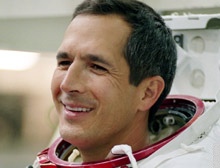 Native American astronaut John Bennett Herrington NASA photo |
U.S. Navy Commander Herrington flew from NASA's Kennedy Space Center with six other astronauts to the International Space Station. It was the 16th American assembly flight to the space station.
Chickasaw Nation. To honor his Native American heritage, Herrington, a registered Chickasaw, carried a Chickasaw Nation flag on his eleven-day trip. The flag had been presented to him by Chickasaw Nation Governor Bill Anoatubby. Herrington's maternal great-grandmother was of Chickasaw descent.
Students and elders from the Chickasaw Nation witnessed the launch at Cape Canaveral, Florida. Among the special guests was Chickasaw member Pearl Carter Scott, who was taught by legendary Oklahoma aviator Wiley Post when she as 12-years-old.
Spacewalking. While in space, Herrington became the first Native American to go outside a spacecraft for a walk in space. He was accompanied on three spacewalks by astronaut Michael Lopez-Alegria, a native of Spain. They installed on the station a 45-foot 14-ton girder called Port 1. Once the remainder of the truss is completed during later flights, the structure will span more than 300 feet and carry power, data and temperature controls for the station's electronic command post.
The grider is one of several trusses composing the station's exterior backbone. The structure includes an exterior railroad that transports the station's external robotic arm as well as spacewalkers during station assembly missions.
Station Crew. Herrington served as Endeavour's flight engineer for launch and landing of flight STS-113. He and the other shuttle crew members aboard STS-113 — commander Jim Wetherbee, pilot Paul Lockhart, and mission specialist Michael Lopez-Alegria — delivered the Expedition Six crew to the space station and returned the Expedition Five crew from the station down to Earth. The Expedition Five crew had been in orbit five months.
Three Endeavour passengers — Expedition Six crew members Kenneth Bowersox, Donald Pettit and Nikolai Budarin — planned to live aboard the orbiting station for four months, replacing Expedition Five crew members Valery Korzun, Peggy Whitson and Sergei Treschev, who had stayed at the space station a month longer than expected.
Navy Pilot. Selected by NASA in April 1996 to become an astronaut, Herrington has logged over 3,300 flight hours in over 30 different types of aircraft. He is an experienced naval aviator and naval test pilot. Following his tour as a test pilot, Herrington attended the U.S. Naval Postgraduate School where he earned a master of science degree in aeronautical engineering. He is also a Sequoyah Fellow with the American Indian Science and Engineering Society.
top of this page
Learn more about John Bennett Herrington and other astronauts:
-
John Bennett Herrington Biography NASA
Meals for John Herrington in space NASA
Space Shuttles NASA
International Space Station NASA
Human Spaceflight Gallary NASA
International Space Station STO
Second Anniversary of Human Residency of ISS STO
Schedule of future assembly launches for ISS NASA